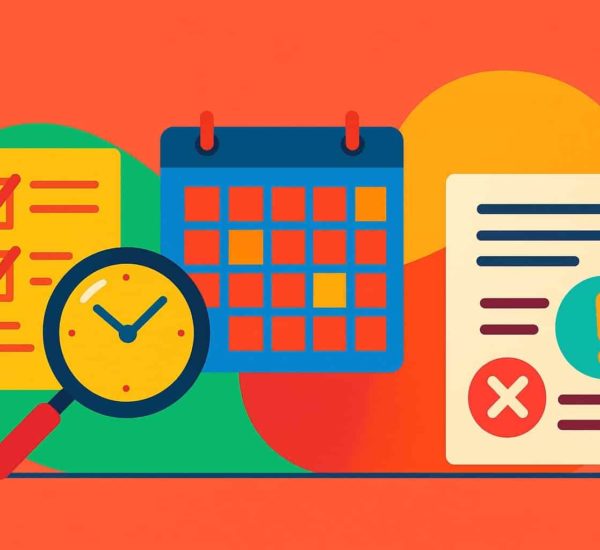Time is a finite resource, yet it often feels like there’s never enough of it. Whether you’re managing projects at work or balancing personal responsibilities, being efficient with time is crucial. But what does that mean in practice, and how can you achieve it? Let’s explore actionable ways to introduce more time efficiency into your day so you can accomplish more without feeling overwhelmed.
What Does Time Efficiency Mean?
Time efficiency refers to using your time in a way that minimizes waste and maximizes results. For example, instead of responding to emails all day, you might allocate 30 minutes in the morning and afternoon to handle them. This approach streamlines your workflow, freeing up time for more critical tasks.
1. Prioritize and Plan
A great way to be efficient with time is by organizing your day around priorities. Start by listing your most important tasks. Then, use tools like time-blocking to allocate specific slots for each activity.
Example: If your goal is to complete a report by the end of the day, allocate two focused hours in the morning and avoid distractions like meetings or social media during that time.
2. Learn to Say No
Taking on too many tasks dilutes your focus. Declining non-essential commitments helps you focus on what matters most.
Example: If you’re asked to attend a meeting that doesn’t align with your priorities, politely decline or suggest an email summary instead. This keeps your schedule open for meaningful work.
3. Use Tools That Save Time
Modern apps and systems are a great place for robust time efficiency wins. For instance, project management tools like Asana or Trello can help you visualize your tasks and deadlines. Tools like Linkody can help digital marketers save time by automating backlink and performance monitoring. Even a simple calendar reminder can keep you on track.
Example: Use scheduling apps to set recurring reminders for weekly check-ins, saving you the trouble of manually setting them each time.
4. Delegate Effectively
Consider assigning a task to someone else if it doesn’t require your expertise. Delegation not only saves time but also empowers others to contribute.
Example: Instead of creating a presentation from scratch, delegate the design work to a team member skilled in PowerPoint. This lets you focus on content creation.
5. Eliminate Time Wasters
Audit your day to identify and eliminate activities that don’t contribute to your goals. Common culprits include excessive social media scrolling or multitasking.
Example: If you find yourself spending 20 minutes deciding what to tackle next, create a daily task list to eliminate that downtime.
6. Build Efficient Habits
Small habits, when done consistently, can significantly impact your ability to utilize time wisely. For instance, setting aside 10 minutes each evening to plan the next day can prevent decision fatigue.
Example: If you know you’ll need to send an email update by 3 p.m., draft it in the morning so it’s ready to send when needed.

Unlocking the Advantages of Time Efficiency
Adopting a time-efficient approach offers more than just crossing tasks off a list. It creates meaningful changes in both your professional and personal life.
1. Increased Productivity
When you’re focused on high-priority tasks and eliminate distractions, you can achieve more in less time. This doesn’t mean rushing—it’s about working smarter.
Example: Instead of spending hours on repetitive tasks like scheduling meetings, using a scheduling app can automate the process, freeing up time for strategic planning.
2. Reduced Stress
A chaotic schedule often leads to anxiety and burnout. Managing your time wisely keeps you organized.
Example: By planning ahead, you avoid last-minute scrambles to meet deadlines, which keeps stress levels low.
3. Improved Work-Life Balance
Being efficient with time at work allows you to leave tasks at the office (or virtual desk) and dedicate quality time to personal interests.
Example: If you manage your daily priorities effectively, you can clock out on time and enjoy dinner with family or dive into a hobby.
4. Enhanced Focus and Decision-Making
A cluttered schedule leads to decision fatigue. Streamlining tasks and avoiding multitasking sharpens your focus, enabling you to make better decisions.
Example: Allocating dedicated blocks for brainstorming or problem-solving reduces the need to make rushed choices later.
5. Greater Opportunities for Growth
When you utilize time efficiently, you can allocate extra hours to self-improvement, such as learning new skills or taking on stretch projects.
Example: If you save two hours a week by automating reporting tasks, that time could go toward a certification course to advance your career.
The benefits of time efficiency compound over time, leading to a more fulfilling, productive, and balanced life. Begin with small, actionable changes, and let the results motivate you to adopt even more strategies.
How to Improve Time Efficiency at Work
Improving time efficiency at work isn’t about putting in more hours—it’s about being efficient with time to achieve better results. Here are actionable strategies to utilize your time effectively and get more done in less time:
1. Set Clear Priorities
Begin each day by identifying your top priorities. Prioritize impactful tasks and tackle them first..
Example: If preparing a client presentation is your priority, allocate focused hours early in the day and avoid distractions like emails or unplanned meetings.
2. Leverage Technology
Using the right tools can make all the difference. From automation to scheduling apps, technology helps you become more efficient with time and simplifies workflows.
Example: Use project management tools or scheduling apps to organize tasks and avoid losing time on manual updates.
3. Minimize Interruptions
Interruptions drain focus and waste time. Creating boundaries during work hours ensures you use time efficiently and don’t suffer from cognitive switching.
Example: Set your devices to “Do Not Disturb” mode and communicate your availability to your team for better time efficiency.
4. Practice Time Blocking
Allocate specific blocks of time for focused work, meetings, and breaks. This helps you stay organized and utilize time efficiently.
Example: Reserve two hours in the morning for creative tasks and a 30-minute slot in the afternoon for emails, ensuring a time-efficient workflow.
5. Take Breaks to Recharge
Counterintuitively, taking breaks boosts productivity. It allows your mind to rest, helping you return to tasks with renewed focus.
Example: After 90 minutes of deep work, take a 10-minute walk to recharge and improve your ability to complete the next task.
By incorporating these practices, you’ll not only work more effectively but also reduce stress and free up more time to focus on what matters most. Being efficient with time allows you to achieve your goals while maintaining balance.

Best Time Management Tools to Improve Efficiency
In today’s fast-paced work environment, leveraging the right tools can make all the difference in how efficiently you utilize your time. Whether you’re managing your schedule, tracking progress, or automating tasks, these resources can help you streamline your workflow and stay on top of your priorities:
1. Task Management Tools
Keeping your tasks organized is essential for time efficiency. Tools like Asana, Trello, and Notion allow you to create to-do lists, assign tasks to team members, and track project progress in real time.
Example: Use Trello to create task cards for each project and set deadlines. This ensures you’re focusing on high-priority items without losing sight of smaller details.
2. Time Tracking Apps
Tracking how you spend your time is key to identifying inefficiencies and staying on track. Apps like Clockify, Toggl, AttendanceBot, and Harvest offer insights into how your hours are divided among tasks, helping you pinpoint areas for improvement.
Example: Use Harvest to monitor time spent on specific client projects and ensure you’re billing accurately while identifying time-draining activities.
3. Workforce Management Software
If you’re managing a team and want to minimize the extra “overhead” of using additional software, tools like AttendanceBot and Harvest are invaluable combining deep time tracking and availability planning within your existing Slack or Microsoft Teams ecosystem. These apps are natively integrating in Slack and M365 so you can analyze data and insight without asking your employees to add another log in or screen while they’re deep into their work.
Example: With AttendanceBot, you can quickly set up Slack/Teams notifications for breaks, overtime, scheduled leave, and timesheet approvals without leaving your workspace. Time-efficiency is gained by surfacing the right information at the right time, and in the right place so you’re not task switching or creating attention residue.
4. Automation Tools
Automating repetitive tasks saves significant time and energy. Tools like Zapier integrate with apps you already use to automate workflows, such as sending follow-up emails or updating databases.
Example: Set up a Zap to automatically save email attachments to Google Drive, eliminating the need for manual uploads.
5. Calendar and Scheduling Apps
Efficient scheduling is essential for managing meetings and deadlines. Tools like Google Calendar ensure you never miss an appointment and help you optimize your day by avoiding overlapping tasks.
Example: Use Google Calendar’s “Focus Time” feature to block out periods for uninterrupted work. Integrate it with Calendly to simplify meeting scheduling with clients and colleagues.
By using these tools strategically, you can minimize time spent on manual processes and focus on high-value tasks.
Summary
Maximizing your time efficiency is about working smarter, not harder. By prioritizing tasks, leveraging tools like AttendanceBot for workforce management, and adopting practices such as time blocking and minimizing distractions, you can make the most of every day. Time efficiency empowers you to achieve more with less effort, freeing up time for what truly matters. With the right mindset, strategies, and resources, you can create a workflow that boosts productivity and reduces stress.



